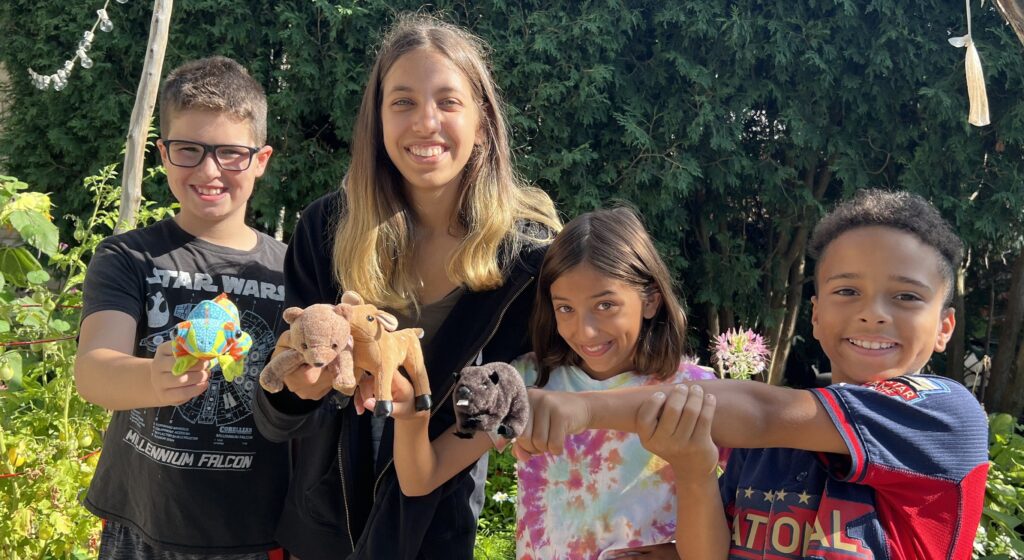There is nothing that can get a group of kids to roll their eyes like talking to them about feelings. The topic of feelings for most kids (and many grown-ups) is boring at best and painful at worst.
When I instead begin the conversation about feelings by introducing the four feelings habit animals, I get a very different response from children: curiosity. When I show kids my deer, bear, beaver and chameleon feelings habit animals, and I talk about my own feelings habits, kids become curious about their own tendencies. Then I have them take the feelings habit animal quiz.

Many Possibilities…
Six simple questions can give kids and grown-ups clues about their feelings habits. Even though the questions are simple, our responses can be varied. You might have multiple responses to a single question because part of you feels one way, and another part of you feels a different way.
Here’s a personal example of having multiple emotions in response to a situation: When my husband gets very busy with work and doesn’t have time to spend with me, a part of me feels indifferent or even happy. His busyness gives me time work on my own projects and do whatever I want to do. However, another part of me thinks that he doesn’t love me. The second part is a small, child-like part of me that is not rational, but it is still there. So if, “Your friend is too busy to play with you” were a question on the quiz, I would put two answers (“I don’t care” and “I think they don’t like me”) because both are aspects of my internal response.
Take the Feelings Habit Animal Quiz
If you didn’t yet take the 6-question Feelings Habit Animal quiz, I’d invite you to do so now. Answer the questions as you would have when you were a child, and discover your childhood feelings habit animal. Then take it with your child and get curious how each of you would respond now. Many of us have more than one feelings habit, so if you write down your responses (a, b, c, d and/or e) on a piece of paper as you go along, you will get a fuller picture of your feelings habits, which might include multiple animals.

Note: The Feelings Habit Animal Quiz comes from The Quest for Self-Compassion Activity books, which will be available in October 2024.
What are the 4 Feelings Habits?
The quiz results for the four feelings habit animals are described below.
Beaver
If you chose mostly A’s, your feelings habit animal is a beaver. Emotions can be sticky for you. Your mind replays situations over and over. A sticky mind can be tricky, but it can also be STRONG.
Bear
If you chose mostly B’s, your feelings habit animal is a bear. You feel BIG feelings. It’s healthy to feel our feelings, but big feelings can sometimes be difficult to manage. Being sensitive can also be a gift.
Chameleon
If you chose mostly C’s, your feelings habit animal is a chameleon. You can sometimes hide from your emotions or distract yourself from tricky feelings. It can cause difficulties when we avoid our emotions, but being able to focus our attention away from our feelings can also be helpful.
Deer
If you chose mostly D’s, your feelings habit animal is a deer. You sometimes feel scared of difficult feelings or think you’re bad. Shame can be a tricky emotion, but just like you, we all wish to be loved. Your care for others can also be a strength.
Other
If you chose mostly E’s, you can choose an animal that matches your feelings habits. How do you normally respond to your feelings? It’s common for our habits to be tricky in some ways and helpful in other ways.
Often people who choose E have a habit of either problem-solving or looking on the bright side when presented with challenges. Problem-solving can sometimes be a resilience habit, and sometimes it can be a form of avoiding feelings (see chameleon). Similarly, looking on the bright side of things can sometimes be a resilience habit, and it can also be a form of upbeat denial if it is coupled with avoidance of difficult emotions.
What do I DO about my feelings habits?
When adults learn about their feelings habit animals, they often want to be handed a “how to solve my feelings habit animal” prescription. Many adults view their feelings habit animals as a problem needing to be solved. I haven’t encountered the same response from most kids. Kids generally appreciate having a playful way to describe their feelings habits, and they like knowing that they are not alone in having these habits.
If you are looking for a fast fix, I would invite you to pause. Taking this quiz with a child offers a way for grown-ups and kids to identify their habits and can facilitate a caregiver-child connection. Helping kids understand that they are not alone in having a hard time with emotions creates an environment where adults and kids can learn and grow side-by-side.
Sometimes when I give kids the quiz, there are kids that try to put what they perceive to be the “correct answer” in the “e” response. Interestingly enough, when I share my own feelings habit animals, kids start to practice a little more self-honesty.
Sharing our Feelings Habit Animals
My feelings habit animals are a bear, a beaver, and a deer. I am a very sensitive person, and my brain can be very sticky. I am also prone to feeling shame about all sorts of things (goes along with the sensitivity and sticky brain). These habits can be liabilities, and they can also be gifts. I wouldn’t be the teacher I am today without my unique blend of feelings habits.
What about you, what are your feelings habit animals? If you’re willing to share your habit animals in the comments, it can help us all feel connected. Remembering that we are not alone in our struggles is a kindness that can contribute to resilience over time.
Wishing you light and love,
Jamie Lynn
Learn more about self-compassion for kids and caregivers and sign up for Resilient Parenting, Parent-Child Self-Compassion, or adult Mindful Self-Compassion classes with Jamie Lynn.
